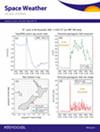Atmospheric Ionizations by Solar X-Rays, Solar Protons, and Radiation Belt Electrons in September 2017 Space Weather Event
IF 3.7
2区 地球科学
引用次数: 0
Abstract
Energetic particles from space deposit their energies on the Earth's atmosphere and contribute to variations in the concentration of neutral components such as ozone which controls the atmospheric temperature balance. Comprehensive understandings of their global impact on the atmosphere require whole pictures of spatiotemporal ionization distributions due to them. We first attempt to evaluate and summarize the altitude profiles of ionization for the September 2017 space weather event with cutting-edge space-borne and ground-based observations of different types of particle inputs. In early September 2017, the Sun showed notable activity, including X-class flares and solar proton events. During this period, ground-based radar observations have confirmed atmospheric ionization events by energetic particle precipitations of solar flare X-rays, solar protons, and radiation belt electrons, the main sources of ionization into the Earth's atmosphere. We estimate the altitude profiles of the ionization rate by using the Particle and Heavy Ion Transport code System (PHITS) with the input of the particle fluxes obtained by satellites. The estimates are then compared with measurements of the ionization altitude, ionization intensity, and electron density by the radars in the polar region, such as the PANSY radar at Syowa Station and the EISCAT in Tromsø, Norway. We conclude that the PHITS simulation results reasonably reproduce (within the error of a factor of two) those ionizations measured by ground-based instruments with inputs of observed ionization sources by satellites.2017 年 9 月空间天气事件中太阳 X 射线、太阳质子和辐射带电子对大气的电离作用
来自太空的高能粒子将其能量沉积在地球大气层中,造成臭氧等中性成分浓度的变化,从而控制大气温度平衡。要全面了解它们对大气层的全球影响,就需要了解它们造成的时空电离分布的全貌。我们首先尝试通过对不同类型粒子输入的前沿天基和地基观测,评估和总结 2017 年 9 月空间天气事件的电离高度剖面。2017 年 9 月初,太阳出现了显著的活动,包括 X 级耀斑和太阳质子事件。在此期间,地基雷达观测证实了由太阳耀斑 X 射线、太阳质子和辐射带电子等高能粒子沉淀引起的大气电离事件,它们是进入地球大气层的主要电离源。我们利用粒子和重离子传输代码系统(PHITS),并输入卫星获得的粒子通量,对电离率的高度分布进行了估算。然后,将估算结果与极地地区雷达(如 Syowa 站的 PANSY 雷达和挪威特罗姆瑟的 EISCAT)对电离高度、电离强度和电子密度的测量结果进行比较。我们的结论是,PHITS 模拟结果合理地再现了地面仪器测量到的电离情况(误差在 2 倍以内),并输入了卫星观测到的电离源。
本文章由计算机程序翻译,如有差异,请以英文原文为准。
求助全文
约1分钟内获得全文
求助全文

 求助内容:
求助内容: 应助结果提醒方式:
应助结果提醒方式:


